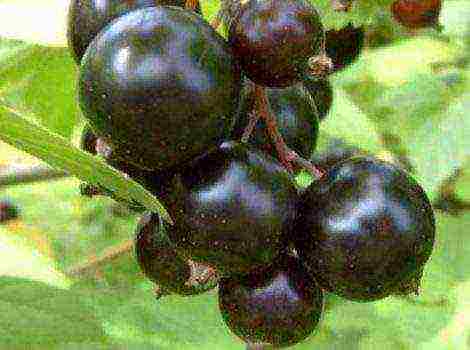Content
- 1 Strawberry repair and its features
- 2 🎥 Video help from Marina Akimova "Review of the best remontant varieties of strawberries"
- 3 ★ The best varieties of remontant strawberries
- 4 Fertilizing and feeding remontant strawberries
- 5 How to feed a berry during flowering
- 6 Feeding remontant strawberries with yeast
- 7 Typical diseases and pests of strawberries
- 8 Rating of the best remontant varieties
- 9 Heading "Question-answer"
- 10 What is a remontant grade
- 11 The most delicious representatives
- 12 Transportable varieties
- 13 1. Queen Elizabeth 2
- 14 2. Temptation
- 15 3. Diamond
- 16 4. Evie 2
- 17 5. Moscow Delicacy
- 18 6. Albion
Every gardener would like strawberries on his site to bear fruit as long as possible. As if listening to their desires, tireless breeders bred remontant strawberries. What are the features of these varieties, and which ones are the best? Consider in the article.
Strawberry repair and its features
Remontant strawberry varieties bear fruit several times in one season. The first harvest ripens as usual - in July. The second is expected in August, the third - in the fall. This last crop will only be harvested if there is no frost or if the strawberry is growing in greenhouses. Flower buds, from which the crop will later be formed, remontant varieties are laid during daylight or neutral daylight hours.
The second crop is more plentiful - it accounts for 70-80% of the total fruiting. And this can lead to the fact that the bush will die. The harvest takes place on both maternal and young plants formed at the beginning of the season after the rooting of the antennae. If the peduncles are removed in the spring, then the volume of the second crop can be increased.

Renovated strawberries are a great choice for gardeners looking for a big harvest.
Repairing strawberries participate in an accelerated development cycle, which is why they are rapidly aging, therefore, next year, even large-fruited varieties will produce small berries.
To avoid these disadvantages, you need to follow these rules:
- planting seedlings should take place on a new bed from July to September;
- after planting seedlings, all flowers must be cut off;
- instead of seedlings, you can use antennae-offshoots from mother bushes, or use seeds;
- when fruiting ends - in the fall, before the first frost, the bushes must be removed from the garden;
- the beds must be mulched - with straw, sawdust, hay, dry leaves, weeds cut down. Read also the article: → "Mulching strawberries with sawdust."
The place for the growth of remontant strawberries should be spacious, well-lit. The soil is fertile. The distance between the bushes is at least 40 centimeters; between the rows - 60. Between two adjacent rows, it is good to plant garlic, which will drive slugs away from the bushes.
🎥 Video help from Marina Akimova "Review of the best remontant varieties of strawberries"
Expert gardener Marina Akimova tells in detail which varieties of remont strawberries to choose for the garden ⇓.
★ The best varieties of remontant strawberries
These varieties can be small-fruited, large-fruited. Each of these species can represent their best varieties.
Small-fruited, with small berries
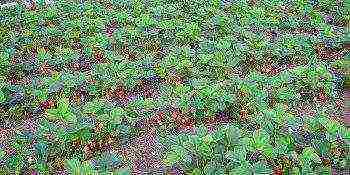
Large-fruited varieties bear fruit before the onset of frost
They are often called strawberries. Small-fruited strawberries do not develop whiskers.It reproduces only by seeds. But its main advantage is that it bears fruit continuously, until the very frost. The best varieties of small-fruited strawberries:
- Ali Baba. A plant with semi-sprawling powerful bushes 15 centimeters high, on each of which many inflorescences are formed. Conical fruits of red color with white pulp have a pleasant forest aroma. Berry mass - 3-5 grams. It is a high-yielding variety that is resistant to diseases and pests. Winters well.
- "Alexandria". The weight of the berries is 7 grams. High-yielding variety. Unpretentious care.
- "Forest Fairy Tale". A large number of flower bearers are formed on compact, medium-sized bushes. Flowering occurs continuously. The fruits are conical in shape. Their taste is sweet and sour. Weight - 5 grams. High-yielding variety.
- Ruyana. The bushes are compact. The bright red fruits are rather large, juicy, with a rich aroma of wild strawberries. They ripen two weeks earlier than other varieties. The variety is high-yielding, resistant to pests, diseases, drought. Well tolerates winter.
- "Rugen". It also begins to bloom and bear fruit earlier than others. The bright red conical berries are very aromatic and tasty. The variety is considered dessert.
- "Baron Solemacher". Bright red fruits with convex blotches weigh up to 4 grams. They are sweet, without sourness, very tasty. The variety is resistant to disease.
Large-fruited, high-yielding varieties
The mass of these varieties of berries varies from 20 to 70 grams, and sometimes reaches 100. They form a small number of tendrils. Unlike small-fruited, these varieties bear fruit only two to three times in one growing season. Read also the article: → "The best varieties of strawberries."
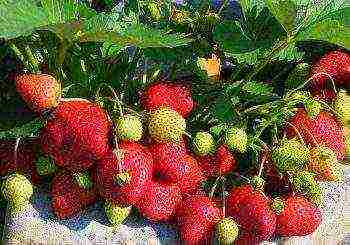
This is how the fruits of remontant strawberries look close-up.
- "Queen Elizabeth". Bushes are powerful, light-leaved. The berry weighs 50-125 grams with medium density pulp. The variety is renewed annually. It is used for vertical gardening, cultivation on hills.
- "Temptation". This is a hybrid variety. Fruiting occurs from May to autumn frosts. Fruits with a nutmeg flavor, with a dense, juicy pulp weigh 30 grams. This variety is used in ornamental gardening.
- "Dynamite". American variety. Berries with light pulp weigh 20 grams. During the growing season, it forms many antennae. Very resistant to pests and diseases.
- "Evie 2". English variety. The fruits are juicy and sweet, weighing 20 grams. Differs in drought resistance.
- "Moscow delicacy". The variety is distinguished by vigorous, strong bushes and abundant fruiting. The weight of the berries is 15-35 grams. Smooth fruits have a cherry aftertaste. Resistant to disease and frost.
- "Albion". This variety is characterized by excellent transportability. The dark red dense berries have a sweet taste and strong aroma. Resistant to weather conditions.
- San Andreas. Bushes are powerful. Fruit weight is about 30 grams or more. Their taste is harmonious. They are of medium density.
- Monterey. American variety. Strong bushes. The cone-shaped berries, juicy and sweet, weigh 20 grams. High-yielding variety. It grows poorly in a continental climate.
- Capri. High-yielding variety. Conical fruits weigh 35 grams.
Repair strawberries differ from common varieties:
- several waves of fruiting;
- large-fruited;
- early maturity.
It also has its disadvantages:
- plants age quickly;
- from year to year the fruits become smaller;
- its berries are less tasty than the berries of ordinary garden strawberries;
- bushes and leaves are weaker.
Fertilizing and feeding remontant strawberries
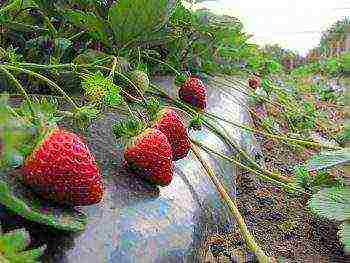
An original way to grow remontant strawberries, which will bring an excellent harvest of fruits
In the soil for growing remontant strawberries, melt water should not stagnate, but it should absorb moisture well. Therefore, organic fertilizers must be added to it. Especially a lot of them are needed on heavy clay substrates. For this, wood ash, humus, bird droppings are used.
Strawberries are in dire need of feeding during the growing season. Therefore, during this period, organic fertilizers must be added to the irrigation water once a week. But even with regular feeding, remontant strawberries do not have enough nutrition. Due to its ultra-high yield and high activity, it so badly needs additional portions of micro- and macroelements.
Tip # 1. It is necessary to feed the plant roots with liquid complex fertilizers for berries every month.
If it is not possible to use organic substances every week, it is necessary to increase the amount of the working solution of complex fertilizers for each bush with monthly feeding. In this case, the concentration of the mixture is prepared strictly according to the instructions.
- They feed remontant strawberries at least 3 times a year, and just in time. Until the foliage grows rapidly, it can be fed from a solution of manure and ammonium sulfate. Read also the article: → “How to feed strawberries in the fall. The experience of gardeners ”.To do this, 1 tablespoon of sulfate is mixed with 2 cups of cow dung and diluted in 10 liters of water. 1 liter of solution is poured under each bush.
- In the first year of planting, plants are watered with a mullein solution (1 glass per 5 liters of water) at the rate of one glass of the mixture for each bush. Nettle infusion works well: a bucket of freshly picked herbs is poured with water and left to infuse for 3 days. You can spray the bushes with this infusion for the first time even before the strawberries bloom. The second is when the crop is harvested.
- At the end of May, before flowering, it is also fertilized with a mixture of 10 liters of water, 2 tablespoons of nitrophoska and 1 teaspoon of potassium sulfate. Pour 0.5 liters of this fertilizer under each bush.
- It is advisable to carry out top dressing in the spring, before the leaves bloom. This can be done simultaneously with the removal of old whiskers and leaves, as well as transplantation.
How to feed a berry during flowering
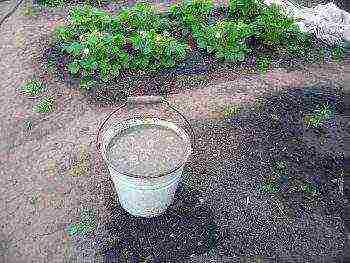
You can feed strawberries with chicken droppings and humus very carefully, because when you fall asleep a bush, you risk ruining the entire future harvest.
- Strawberries need a lot of potassium to form fruit. Therefore, as a top dressing, you can take an infusion of chicken manure, ash or potassium nitrate.
- During the flowering period, strawberries are sprayed with 0.02% zinc sulfate solution. At the very beginning of flowering, it can be fertilized with a mullein solution. In order to increase the yield, strawberry bushes are sprayed with microelements during flowering and the formation of ovaries: add a pinch of boric acid to 10 liters of water. You can also use ready-made fertilizers created specifically for strawberries.
- The yield of berries can be increased by 30% using a complex fertilizer, which contains all the necessary trace elements.
- However, feeding remontant strawberries is needed not only during flowering. Secondary fertilizers should be added to the soil immediately after the main crop is harvested - in mid or late July. Leaves and whiskers are cut at the same time. Then the bushes are treated with a solution of 2% Bordeaux liquid to destroy parasites and insects living in plants.
- The last time young plants, which are one year old, are fed in mid-September in dry weather.
Feeding remontant strawberries with yeast
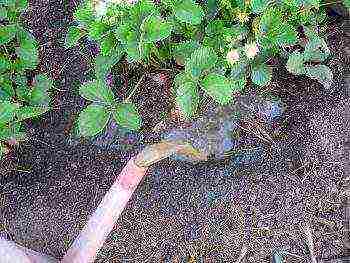
Feeding strawberries in spring with boric acid
More recently, gardeners and gardeners began to use yeast to feed strawberries. This improves the yield. Yeast can be used as fertilizer for other berries and vegetables. Plants are fed 2 times per season. A 5 liter bucket is usually enough for 10 bushes. A 1-kg pack of yeast is diluted in 5 liters of water.
Tip # 2. For feeding, 0.5 liters of the mixture is diluted in 10 liters of water. Pour 0.5 liters of the mixture under each strawberry bush.
In addition to the usual, fast yeast can be used. 1 bag of dry yeast and 2 tablespoons of sugar are diluted in a little warm water and left to infuse for 2 hours. When watering, add 0.5 liters of solution to the watering can.
Typical diseases and pests of strawberries
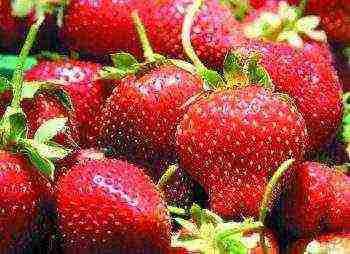
This picture perfectly shows what a big harvest a remontant strawberry gives with proper care.
The most dangerous diseases:
- gray rot (see → how to treat gray rot on strawberries),
- powdery mildew (how to treat powdery mildew),
- late blight wilting,
- brown spot,
- brown, white, angular spotting.
Agrotechnology of remontant strawberries provides for the prevention and control of pests and diseases. The main preventive measure is the selection of resistant varieties. The reason for the total spread of fungal infections can be high humidity, dense plantings. Mulching does not allow strawberries to come into contact with waterlogged soil, and this saves them from rot. Read in more detail: → "6 diseases and 5 main pests of strawberries: how to treat and how to fight."
Strawberries cannot be planted in a place where tomatoes, peppers, potatoes used to grow, from which they can inherit verticillary and fusarium wilting. At the first symptoms of the disease, the bushes must be immediately treated with 2% Bordeaux liquid, potassium permanganate or phytosporin.
To suppress the dangerous pest of strawberries - the strawberry mite, insecticides are used. But they can only be applied after harvest. If there are aphids in the leaves and shoots of strawberries, it can be scared off with a solution of laundry soap with the addition of wood ash.
Rating of the best remontant varieties
Vima Zanta ripens in early summer:
| Ripening time | Berry weight (g) | Productivity (kg per bush) | Distinctive properties |
| Late May - early June | 40 | 0,6-0,8 | High permeation |
Gigantella has large berries and high yields:
| Ripening time | Berry weight (g) | Productivity (kg per bush) | Distinctive properties |
| June | 60-125 | 1-3 | Good transportability |
Strawberry variety Diamant is resistant to various diseases:
| Ripening time | Berry weight (g) | Productivity (kg per bush) | Distinctive properties |
| From late May to early June | 20-40 | 1-2 | Resistant to viruses and diseases |
The Dukat variety is considered frost-resistant, not afraid of cold weather:
| Ripening time | Berry weight (g) | Productivity (kg per bush) | Distinctive properties |
| From late May to early June | 20-40 | 1-2 | Frost resistant |
Kent begins to ripen in the first month of summer:
| Ripening time | Berry weight (g) | Productivity (kg per bush) | Distinctive properties |
| In the first half of June | 40 | 0,7-1 | Frost resistance. Resistant to gray mold and powdery mildew |
Clery is not afraid of gray rot and frost:
| Ripening time | Berry weight (g) | Productivity (kg per bush) | Distinctive properties |
| At the beginning of June | 20-40 | 0,7-1 | Resistant to fungal diseases and diseases of the root system |
Queen Elizabeth II is popular for its large and sweet berries:
| Ripening time | Berry weight (g) | Productivity(kg per bush) | Distinctive properties |
| May to October | Up to 110 | 1-2 | Resistant to viruses and diseases |
Olbia is not afraid of drought and rare watering:
| Ripening time | Berry weight (g) | Productivity (kg per bush) | Distinctive properties |
| Mid May to Mid June | 30-40 | 0,6-0,7 | Frost-resistant, drought-resistant |
Honey bears fruit for more than a month, tolerates long transportation well:
| Ripening time | Berry weight (g) | Productivity (kg per bush) | Distinctive properties |
| Mid May to Mid June | 30-40 | 0,5-0,7 | Frost resistance, well transported |
Elsanta is a high-yielding variety, but does not like drought:
| Ripening time | Berry weight (g) | Productivity (kg per bush) | Distinctive properties |
| June | 40-50 | 1,5 | Needs regular watering |
Heading "Question-answer"
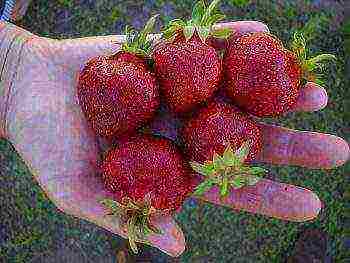
Berries of remontant strawberries close-up, the fruits of this variety are quite voluminous and in large quantities, with simple care
How to care for remontant strawberries?
Experienced summer residents argue that large-fruited remontant strawberries (popularly called rem. Strawberries) need not only regular feeding, a high level of agricultural technology, but also a significant frequent replacement of fruiting bushes.Of course, the bush will bear fruit the next year, and in a year, however, the yield may significantly decrease, compared to that which will give a young plant.
Therefore, in late spring or early summer, you need to leave a little mustache from young (at the age of 1 and a little over a year) well-bearing plants. As soon as the whiskers take root, they should be separated and planted for growing in containers, or immediately in the place of their permanent cultivation in the next season. The young plant is grown, the bush is allowed to develop, and fruiting is allowed in the second half of summer. The main work of the remontant strawberry lies in the next season.
Thus, remontant strawberries are grown for 1.5 seasons, then the aged plant is removed. To make the most of the opportunities, accelerate the onset of fruiting and extend it in the fall, it is better to cover the remontant strawberries with a non-woven cloth, with periodic access of pollinating insects.
Rate the quality of the article. We want to be better for you:
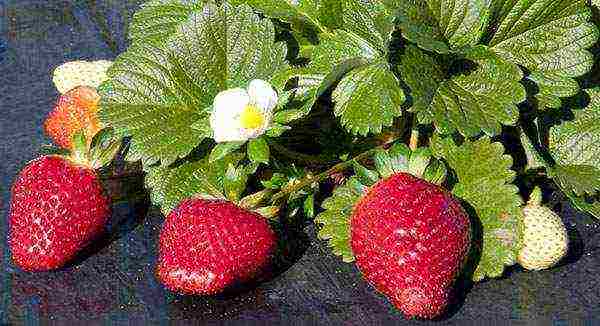 You can get harvests of fragrant berries throughout the warm season if you plant remontant varieties of garden strawberries on the garden bed. These are fast-growing and abundantly fruiting crops that will yield 3 harvests per season.
You can get harvests of fragrant berries throughout the warm season if you plant remontant varieties of garden strawberries on the garden bed. These are fast-growing and abundantly fruiting crops that will yield 3 harvests per season.
What is a remontant grade
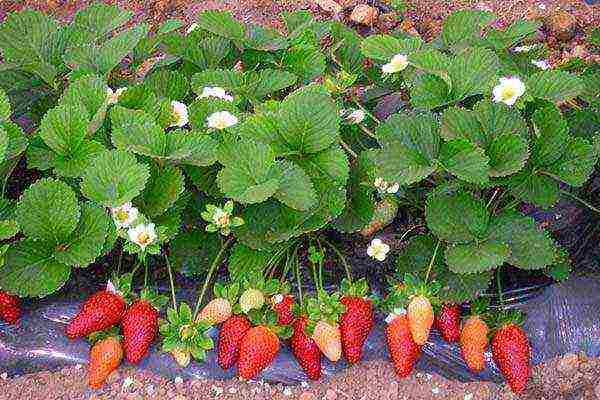 Remontant plants include plants that lay flower buds throughout the growing season, regardless of the length of daylight hours. That is why flower stalks, green and ripe fruits are always present on one plant.
Remontant plants include plants that lay flower buds throughout the growing season, regardless of the length of daylight hours. That is why flower stalks, green and ripe fruits are always present on one plant.
Advantages of varieties:
- fast growth;
- abundant fruiting in the year of planting;
- resistance to spider mites and other diseases and pests typical for strawberries;
- good taste;
- high decorative effect.
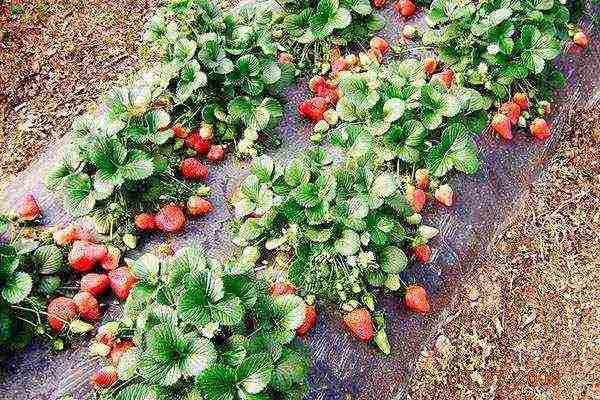 The only significant disadvantage of such strawberries is the need for annual planting renewal. The reason is the rapid aging of the plant.
The only significant disadvantage of such strawberries is the need for annual planting renewal. The reason is the rapid aging of the plant.
If the bushes are left for another 1 year, the yield will be low and the berries will be small.
The first harvest of remontant varieties of garden strawberries is harvested in June-July, the second in August and the third, in favorable weather, in September-October. In the southern regions, berries are harvested even in November. The main thing is that at night the air temperature does not drop to minus.
The most delicious representatives
 Most varieties of remontant garden strawberries are distinguished by a sweet and sour fruit taste and good juiciness. They are suitable for fresh consumption, freezing and processing. Almost anything can be grown on the balcony and used for vertical gardening.
Most varieties of remontant garden strawberries are distinguished by a sweet and sour fruit taste and good juiciness. They are suitable for fresh consumption, freezing and processing. Almost anything can be grown on the balcony and used for vertical gardening.
The best varieties of garden strawberries for the middle lane:
- Queen Elizabeth II - tops the lists of the most demanded and fruitful varieties. The bushes of the plant are tall with large peduncles. The berries are sweet, reaching a mass of 50 to 100 g. It is resistant to frost. When grown between the bushes, a distance of 40-60 cm is maintained. The first fruits are removed in late May - early June.

- Evie 2 - drought-resistant culture of English selection. Fruits are round in shape, weighing 25 g, juicy, fleshy. The advantage of the variety is the ability to grow for 2 or more years in a row in one place without renewal. Provides stable yields of berries of the same size. Resistant to temperature extremes and adverse weather conditions.
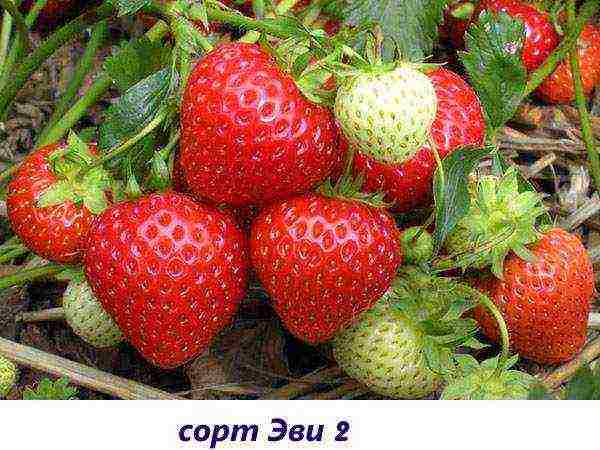
- Maestro - a variety of French selection. Berries of average size, weighing 35-45 g. Fruits are conical, sweet, ripen evenly, do not rot in wet weather. The variety is characterized by increased immunity to major diseases.
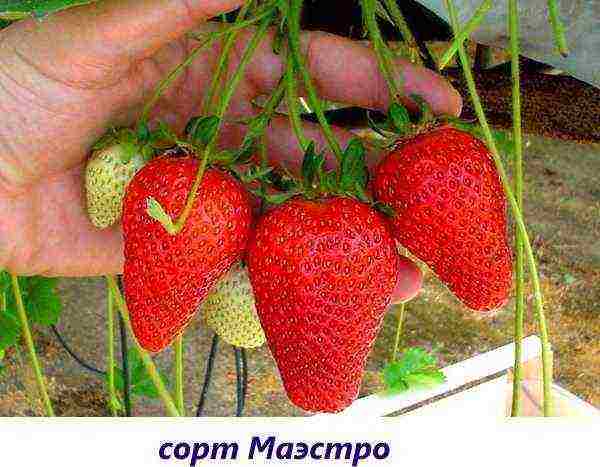
- Portola - forms tall, branched bushes. The berries are heart-shaped, sweet, 70-80 g. Mid-season variety, resistant to waterlogging and fungal diseases. By the end of the season, the plantings are covered with foil to get the fourth crop. When planting, a distance of at least 60 cm is maintained between the rows.
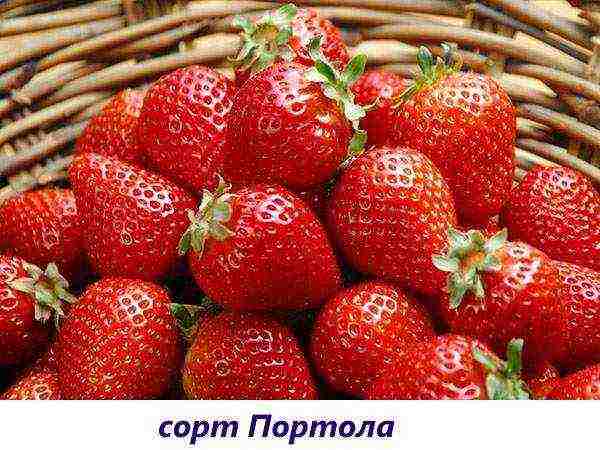
- Temptation - one of the few varieties that gives large fruits with nutmeg notes. The berries are juicy, weighing from 30 g. The bushes are tall with large leaves, so the plant tolerates heat and drought well. Used for vertical gardening.
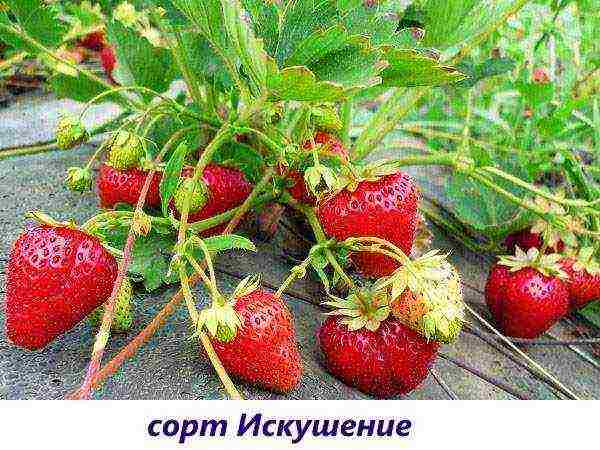
The described varieties of remontant garden strawberries have been grown in the middle lane for many years, therefore they are well studied and adapted to climatic conditions. They are successfully grown in open and closed ground, on vertical slides and horizontal beds.
Transportable varieties
Farms, when choosing remontant varieties of garden strawberries, always take into account the characteristics of berry density and transportability. These properties directly affect the amount of profit received. Among the varieties whose fruits tolerate transportation well, the following are distinguished:
- Albion - forms a tall bush, giving 4 harvests per year. The berries ripen scarlet, juicy, cone-shaped, weighing 70-80 g. Drought-resistant, well transported over long distances without losing their presentation.

- Charlotte Is a weather-resistant variety with a bright wild strawberry flavor. The berries are heart-shaped, weighing from 20 g. The pulp is firm and sweet, the berry is well stored even when fully ripe.
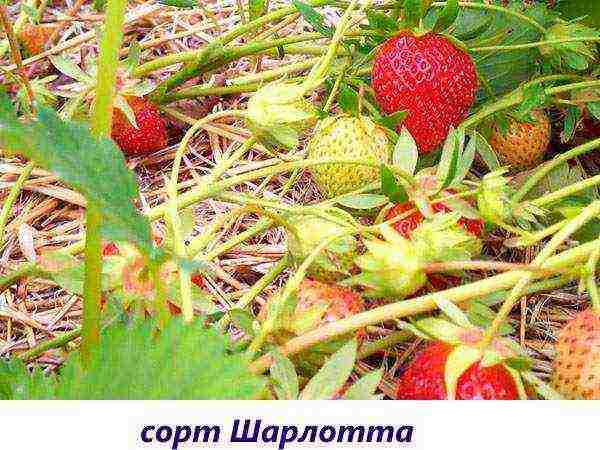
- Selva - high-yielding, large-fruited, American selection. Berries weight from 30-50 g. Fruits are dense and strong in the shape of a cone. Forms a large bush with 20 or more peduncles.
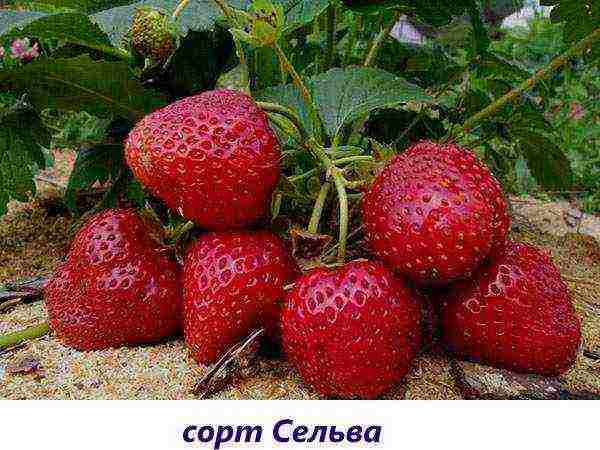
- Flamenco - a variety of English selection. Berries are red-orange, dense, weighing 30-40 g. Medium late variety. The first crop is harvested in July, the second in September. Yields are consistently high. During storage, the berry is not darker and does not lose density.

- San Andreas - large-fruited and high-yielding representative of American selection. Up to 3 kg of berries are harvested from one bush. Fruits are heart-shaped, scarlet, sweet, weighing 40 g.

All remontant varieties of strawberries are distinguished by the fact that when grown, even in a small area, they allow you to get a high yield of delicious berries. The main thing is to regularly feed the plants and remove the red leaves.
Reparability is the ability of plants to bloom and bear fruit multiple times during the summer. Initially, varieties of remontant strawberries (garden strawberries) were bred for the southern regions, and only then they began to grow in more northern latitudes. Repairers give 2-3 harvests during the growing season.
Features of remontant varieties
In our country, enough varieties of remontant strawberries have been bred. But both old and modern varieties have a number of characteristics.
- Inflorescences are formed every 35-40 days. The length of daylight hours does not affect the budding of flower buds.
- The higher the temperature, the more active flowering, so remontant strawberries yield higher yields in the south than in the middle lane. However, it can bloom at a temperature of 8-10 ° C.
- The spring wave of fruiting gives 10-20% of the berries from the total harvest per season. The first strawberries are small, the second harvest yields the largest berries over the summer.
- In warm spring, the first crop can be harvested in May. In the spring sun, overwintered autumn buds bloom, strawberries ripen in 2-3 weeks.
- Repair strawberries in most cases are not hardy enough.
Strawberries sold in May (if they are not imported) are remontant varieties, which are covered with foil in order to obtain a super early harvest in April.
Purchase of repaired planting material
There was chaos in the market with varieties in the 90s. Now the trade in varietal material is gradually entering the legal channel. Nurseries have legal restrictions on varietal diversity. They can sell zoned varieties included in the State Register for a given region. Their assortment is small, but all remontant (and not only) varieties are reliable and meet the requirements.
A wider selection is presented at agricultural fairs. You need to purchase varieties only from trusted producers: nurseries from other regions, well-known collectors, fruit growing institutes.
Remaining strawberry varieties: characteristics
Although the repair strawberry was bred for a warm climate, it is now allowed for cultivation throughout the country from the Northern to the Far Eastern climatic zone.
Main characteristics of remontant varieties.
- Productivity. It is given in c / ha, but when grown in the country it is more convenient to count in kg / m2, or the mass of berries from a bush.
- Berry mass. The higher it is, the more large-fruited the variety.
- The pulp of berries. The denser it is, the longer the strawberries are stored. Dense berries are suitable for transportation.
- Taste. Estimated in points: 4.5 and above - excellent (dessert) taste; 4.1-4.4 - good (table) taste; 3.6-4.0 - satisfactory taste; below 3.6 points - bad taste.
- Content of substances. The more sugar and less acid, the higher the value of the variety. The amount of sugar in the berries determines the taste of the strawberries. Dessert and table varieties are high in sugar.
- The purpose of the variety can be table (for fresh consumption and canning), dessert (for fresh consumption), universal (for processing, canning, fresh consumption). Versatile varieties are suitable for mechanical harvesting and transportation.
All remontant varieties of early ripening, the first harvest is obtained in mid-June (for the Central region). In the south, ripening occurs 2 weeks earlier, in the north (Murmansk, Arkhangelsk regions) later, 7-10 days.
Domestic varieties
There are still few domestic remontant large-fruited varieties, but new ones appear every year. In terms of quality, our repair agents are not inferior to imported counterparts.
Garland
Description. Early remontant strawberry. The first wave of the harvest begins on June 8-10.
The bushes are spherical, rather decorative, medium density. The formation is average, the lashes are short green with a pink tinge. The berries are conical, shiny, bright red, without a neck. The pulp is light red, juicy, tender. Strawberries have a strong flavor.
- yield 6.1 kg / m2 (1 kg per bush);
- berry weight 26-32 g;
- pulp of medium density;
- good taste (4.1);
- the appointment is dessert.
Advantages... Large juicy berries. The variety is quite winter-hardy and drought-resistant. Very harvestable.
Flaws... In a rainy summer, it is affected by fungal diseases (especially powdery mildew). Requires high agricultural technology, otherwise the strawberries will be small, with a mediocre taste.
Elizabeth 2
Description... Very productive large-fruited remontant variety. Bushes are erect, powerful, low, semi-spreading with a dense head of leaves. The whiskers are strong, the whiskers are green, the whips are medium in size. Barely rooted, the mustache immediately blooms. In order not to deplete the plant, the processes of fruiting and formation should be separated.
The berries are extremely large, regular oval, with a neck, dark red, asymmetrical, bumpy, ribbed. Very early ripening. The bushes constantly have flowers, ovaries and fruits. The taste is highly dependent on agricultural technology.
- yield 3.5 kg / m2 (600 g per bush);
- berry weight 60-90 g;
- the pulp is dense, juicy, sweet and sour with a rich strawberry aroma;
- excellent dessert taste (4.7 points);
- the appointment is dessert.
Advantages... Very large tasty berries, during the growing season there can be up to 5 fruiting waves. Strawberries keep well without losing their shape. Good transportability, freeze-proof.
Flaws... With an abundance of moisture, the crop becomes watery, unsweetened.
A more detailed description of the varieties of strawberries Elizabeth and Elizabeth 2 can be found in the article "Comparative characteristics of varieties Queen Elizabeth and Elizabeth 2"
Yoke
Description... Strawberries ripen early: in the first decade of June. Semi-spreading bushes, dense foliage cap. The variety does not give a mustache. Berries have a regular conical shape on thick pedicels, shiny, rich orange-red color, have a neck. In the bright sun they turn dark red. Strawberries are aligned, regular in shape, very sweet.
- yield 1.63 kg / m2 (270 g per bush);
- berry weight 17-23 g;
- the pulp is tender, juicy, sweet and sour, with aroma;
- the taste is excellent (4.6 points);
- substance content: sugar 9%, vitamin C 65 mg /%;
- the purpose is universal.
Advantages... Excellent quality, high winter hardiness, good disease resistance.
Flaws... Insufficient drought resistance, strongly affected by the strawberry mite.
Crimean remontant
Description... The bushes are erect with a dense leaf head. The whiskers are numerous, pale red, on thick whips. The flowers are white, located below the leaves. The stalks are thin, quickly lodge when the crop is filled.
The berries are red, broadly blunt-conical, with a neck, and contain more vitamin C than other varieties of strawberries. Fruiting is double: the first wave is in April-May (Crimea), the second is in August-September. In the northern regions, the first fruiting occurs a month later, the second - 12-16 days later. Plants are durable. In one place they grow up to 6 years without reducing the yield. Strawberries are decorative and in Crimea are sometimes planted in flower beds and ridges.
- yield 1.1 kg / m2 (180 g per bush);
- berry weight from 6.5 to 30 g;
- the pulp is pink, juicy, tender;
- good taste (4.1);
- substance content: sugar 6.6%, acid 1.2%, ascorbic acid 86.9 mg /%;
- the purpose is universal.
Advantages. Excellent winter hardiness and drought resistance, sufficient resistance to diseases and pests. It is not affected by powdery mildew.
Flaws... The unevenness and unevenness of berries, which does not lend itself to regulation. With a lack of moisture, strawberries become very small.
Lyubasha
Description... An early remontant variety. The strawberries ripen in early June. The bushes are very powerful, spreading with a dense leafy head. Leaves are medium-sized, pubescent. Usov does not. The flowers are white, the stalks are thick.
The berries are conical, regular, red, very sweet with a high content of ascorbic acid.
- yield 1 kg / m2 (170 g per bush);
- berry weight 12-23 g;
- the pulp is sweet with aroma;
- the taste is excellent (4.9);
- substance content: sugar 12%, ascorbic acid 82 mg /%;
- the purpose is universal.
Advantages... High winter hardiness, good drought and heat resistance. Disease resistance at the standard level.
Flaws... Not resistant to strawberry mites.
Autumn fun
Description... In the middle lane, it gives 2 crops per season: in June and late August-early September. If you cover the bed with a film, then strawberries can be obtained until October. In the south, there may be 3 waves of fruiting. The bushes are medium-sized, semi-spreading. Usulation is moderate.
The berries are small, sweet, and taste better than other varieties that yield the autumn harvest.
- berry weight up to 20 g;
- the pulp is juicy, pink;
- refreshing, dessert taste;
- the purpose is universal.
Advantages... Resistance to strawberry mites and nematodes, resistance to fungal diseases is above average, a lot of strawberries on one bush.
Flaws... Small berries.
European varieties
In Russia there are all the best foreign varieties, you just need to make an effort to find them. European remontant strawberries are less hardy than domestic ones. There are a lot of lunges in the spring, but the varietal plot never freezes completely.
Albion
Description... American-bred repairing strawberries. The cap of the leaves is large and lush. Plants are very heat-resistant and drought-resistant, grow well in the southern regions of the country. Frost resistance and winter hardiness are insufficient, in the middle lane it freezes out even in relatively warm winters. During the summer, they get 3 harvests: in May, June and September.
The berries are large, dark red with a glossy sheen, regular conical shape with a strong strawberry aroma. They are very elongated and resemble a small carrot in shape.
- yield 500-600 g per bush;
- the pulp is dense, lusciously sweet in ripe berries;
- the taste is great.
Advantages... Large, high quality strawberries, smooth berries. Weakly affected by fungal diseases
Flaws... Not suitable for growing in the middle lane. In the south, in winters with frequent thaws, there are many attacks on the varietal plantation.
Vima Rina
Description... Repaired Dutch variety.Semi-sprawling bushes, powerful, with a large head of leaves. The foliage is light green, shiny. Usulation is not strong, the mustache is green.
The berries are large, red, conical in shape, with a neck, on thin pedicels, they quickly lodge when filled.
- yield 0.85 kg / m2 (140 g per bush);
- the pulp is dense, tender, sweet and sour, juicy, aromatic;
- excellent dessert taste (4.8);
- substance content: sugar 8.3%;
- the purpose is universal.
Advantages... Resistant to drought and heat-resistant, it is almost impossible to overheat it, even in the south. It is well transported and stored for 5-7 days.
Flaws... Low productivity from a bush, insufficient winter hardiness.
Elizabeth
Description... A very large-fruited variety of English selection. Bushes are powerful with large shiny leaves. Mustache formation is insignificant. For reproduction of Elizabeth, a mustache should be taken in the first year of cultivation, since in subsequent years she practically does not give a mustache. Flowering wave-like 2 times per summer (more in the south). Harvest in late May, July and early September.
The berries are very large, shiny, juicy, sweet. Sourness can only be found in incompletely reddened strawberries.
- yield 350-400 g per bush;
- berry weight 30-45 g;
- the pulp is dense, juicy, tender, with aroma;
- excellent dessert taste;
- the purpose is universal.
Advantages... Excellent quality strawberries, continuous fruiting throughout the summer. The berries are well transported without being damaged. Bushes are practically not affected by gray mold and powdery mildew.
Flaws... Insufficient winter hardiness. The term of operation of the varietal plantation is 2-3 years, then the berries become smaller.
Semi-renovated varieties
Some strawberry varieties that have long been grown by summer residents are semi-renovated: Zenga Zengana, Talisman, Bohema, Red Gauntled. They lay flower buds in cold spring, the second wave of fruiting occurs in August. The berries are large, but there are few of them; fruiting is extended until September. In warm spring, semi-renovated plants do not bloom again and give only one harvest.
Bohemia
Description... An excellent variety of domestic selection. Recommended for cultivation in the Central region. Late ripening (from July 10-15). Bushes are powerful with a dense head of foliage. The mustache is thick, bright green.
Berries on thick long stalks, large, conical in shape without a neck, dark red, shiny. It is a source of ascorbic acid.
- yield 1 kg / m2 (170 g per bush);
- berry weight 16-24 g;
- the pulp is dense, juicy
- the taste is excellent (4.5 points);
- substance content: sugar 9.9%, acid 0.9%, ascorbic acid 99.8 mg /%;
- the purpose of the variety is universal.
Advantages... Drought resistance, winter hardiness, high productivity, disease and pest resistance above the standard. Suitable for mechanical cleaning and transportation over distances up to 90-100 km.
Flaws... In the middle lane and to the north, even under favorable conditions, it often does not have time to give a second crop.
Zenga Zengana
Description... A very old German variety. Was put into freeze. Strawberries are firm, do not soak, retain their shape after defrosting.
The berries are medium in size, firm, red, with a shine. In bright sun, they can take on a dark red color.
- weight 16-20 g;
- the pulp is juicy, sweet and sour, with aroma;
- the taste is good;
- the purpose is universal.
Advantages... Suitable for long distance transportation and freezing. Unpretentiousness of plants, they grow well in any conditions of our country. Resistant to powdery mildew.
Flaws... Strawberries are not resistant to strawberry mites, gray mold and leaf spots.
It is impossible to choose a good strawberry just by description. There are no bad varieties. Any variety must be grown and tested under real conditions to assess product quality. Only in this way can he reveal his qualities or not show them at all. It all depends on the skill of the gardener.
Looking for strawberries for your summer cottage? Then this is for you:
- The best varieties of strawberries with photos and descriptions. New, promising and productive.
- Strawberry Elizabeth and Elizabeth 2 description and reviews. What is the difference between these varieties and which one to choose after all.
- Strawberries Gigantella Maxim. Consider whether to plant it.
- Strawberries Festivalnaya, reviews and recommendations for care. Unkillable Festival, why is she still loved by gardeners.
- Asia variety description. Capricious Asia, how to grow it.
- Lord variety description. An unpretentious and productive Lord.
- Honey Strawberry. Undemanding and productive variety, but more suitable for processing.
- Wima Kimberly: description and agricultural technology. A versatile strawberry loved by gardeners in all regions.
- Clery: a description of the variety, reviews and a brief agricultural technique. A strawberry that loves the sun very much.
- Strawberry Alba: description, reviews and agricultural technology. A very good variety for sale in the market.
- The varieties are weeds on the strawberry plantation. Where do they come from?
Save article to:
Dear visitors of the "Dacha Plot", tireless gardeners, gardeners and flower growers. We offer you to pass the aptitude test and find out if you can trust the shovel and let you into the garden with it.
Test - "What kind of summer resident I am"
Share this article with your friends:
Who does not dream to feast on
strawberries
all summer! If earlier the gardener tried to prolong, as much as possible, the fruiting of bushes with his favorite berries, then nowadays you can pick strawberries from early spring until the onset of cold weather.
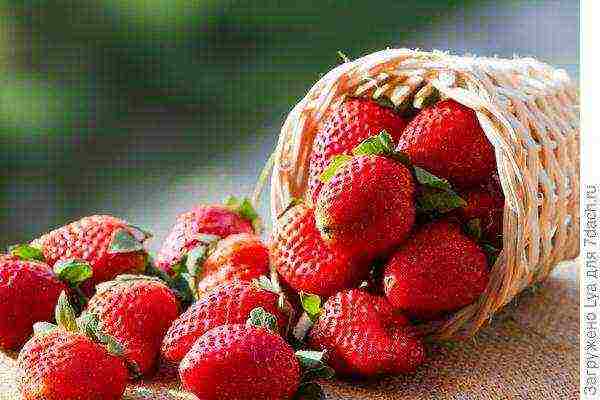
And how much you can have time to prepare, having an unlimited amount of the cherished delicacy! I propose to get acquainted with the varieties of remontant garden strawberries, which can decorate and enrich not only your diet, but also the garden, and even the balcony.
1. Queen Elizabeth 2
The berries of this variety are very large - about 45-50 g of a piece, and the largest ones even reach 125 g. The pulp is of medium density, with juiciness inherent in the variety. This variety must be renewed every year so that the berries do not shrink.
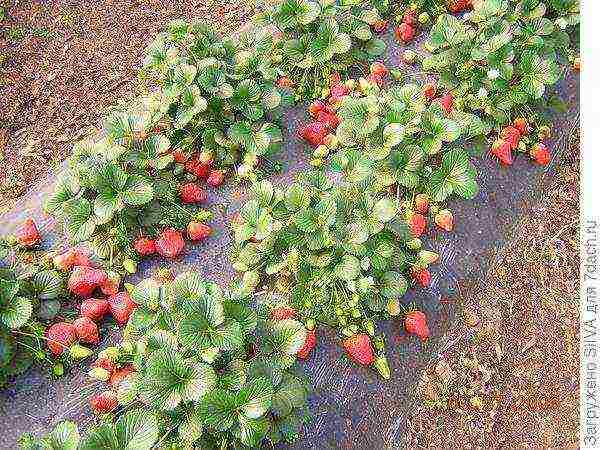
Suitable for cultivation on slides and for vertical gardening. Will bear fruit even on outlets in the first year after planting.
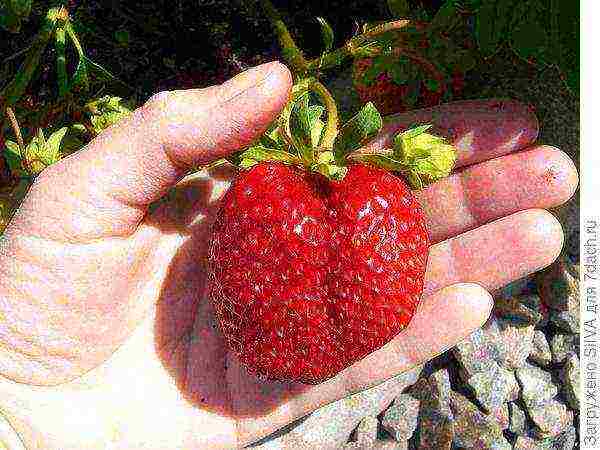
2. Temptation
A hybrid with a unique nutmeg flavor. From May until frost it will delight with large, about 30 g berries. The pulp is firm, but very juicy. The flower stalks are long, which makes this variety especially attractive for decorative floriculture. Suitable for cultivation both in the garden and in the potted version. Perfect for vertical gardening.
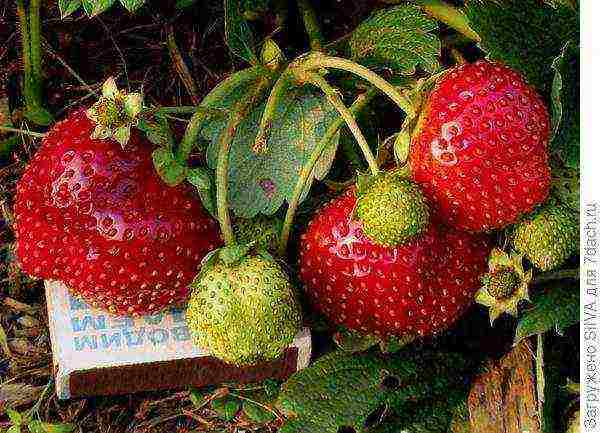
More than 20 peduncles can be located on one adult bush. After 1.5 months after planting the seedlings, it is already possible to harvest (about 1.5 kg per bush). The zest of the variety is its year-round harvest. This is because immediately after planting, the plant begins to form a crop that will not be affected by the length of daylight hours and the season. This is probably why many choose the variety for planting on the balcony.
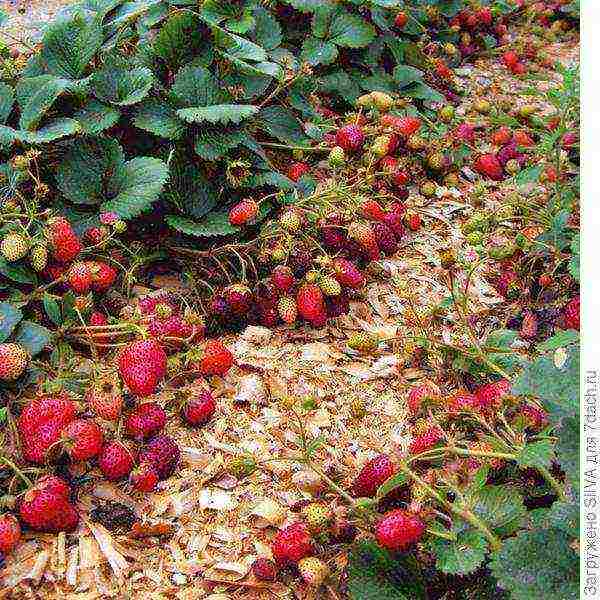
3. Diamond
This garden strawberry is the creation of the University of California. In our country, in terms of its taste and productivity, it is considered one of the best adapted remontant varieties. The pulp of the berries is light in color; during the growing season, it actively forms a mustache. Resistant to diseases and pests (spider mites). Berry size from 20 g.
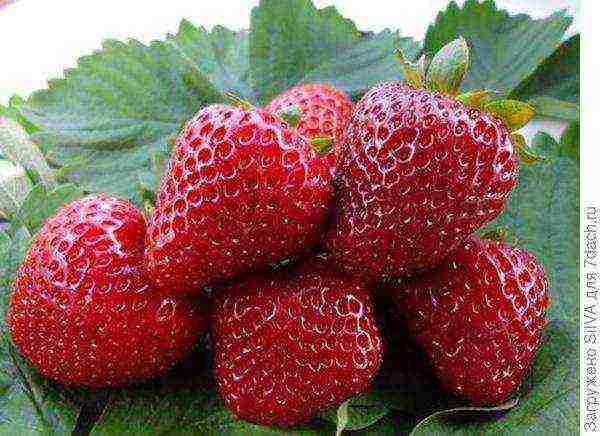
4. Evie 2
The pulp of this variety is very juicy, fresh and sweet. From 10 sq. m can be collected up to 55 kg. Large berry weighing about 20 g, rounded, scarlet. The Evie 2 variety owes its origin to the English selection of the county of Kent. Differs in good drought resistance.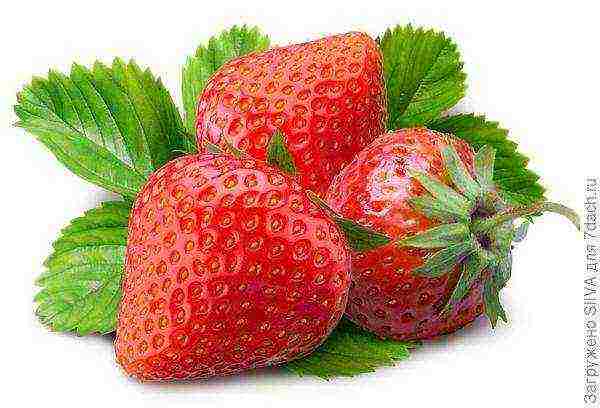
5. Moscow Delicacy
A variety of neutral daylight hours, the average weight of berries is about 15 g, the maximum is about 35 g. Fruits very abundantly until frost. In addition to high yields, this variety is characterized by good frost resistance and disease resistance. The bushes of the variety are strong, the peduncles are tall, powerful, not lodging.The berries are smooth, red, with some aftertaste
cherries
.

6. Albion
In terms of transportability, there are few equal to this berry. It is an extremely drought tolerant variety with powerful, non-sticking peduncles that prevent the berries from bending towards the ground. Very large dark red berry with very firm pulp. In the south of Russia it does not require shelter, in the middle lane it is necessary to shelter for the winter.
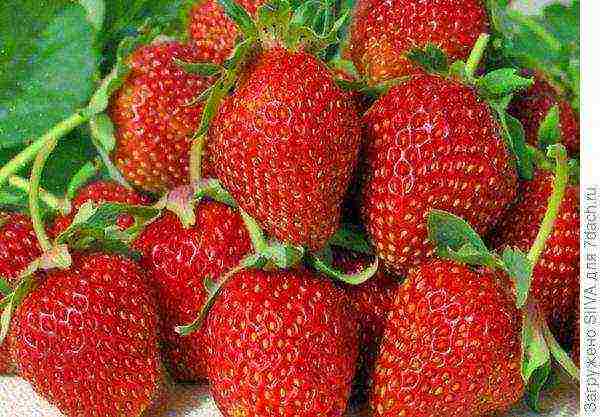
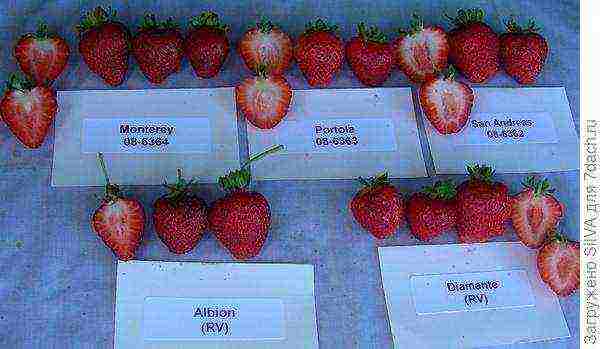
So, now you know several refurbished strawberry varieties that can delight you with a berry all year round. Choose to taste, or you can plant everything at once and see what you like best. Or maybe you already have some other remontant varieties of garden strawberries? Share with us!
